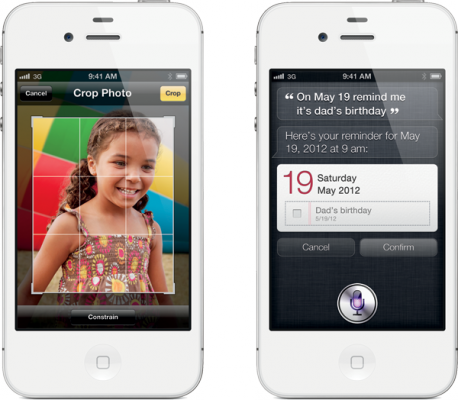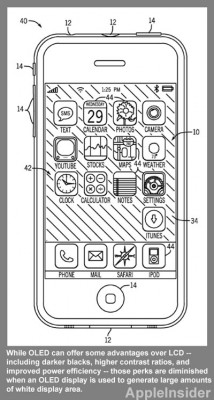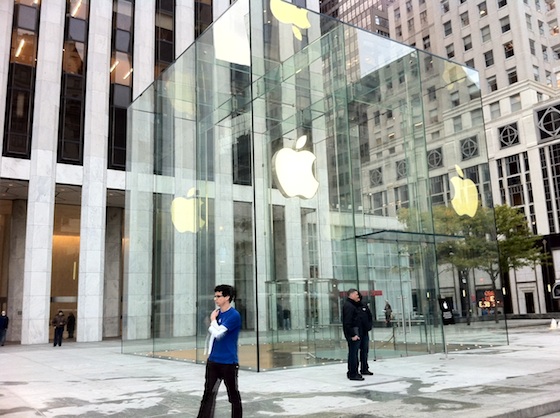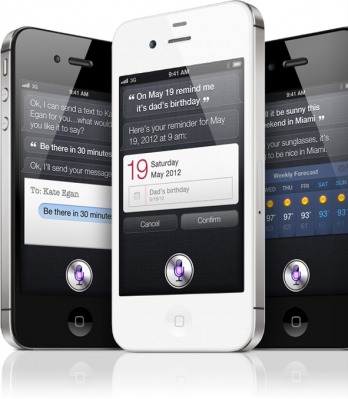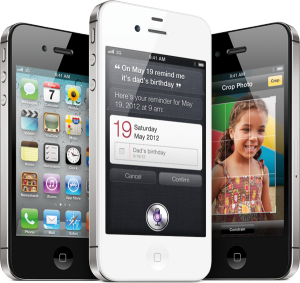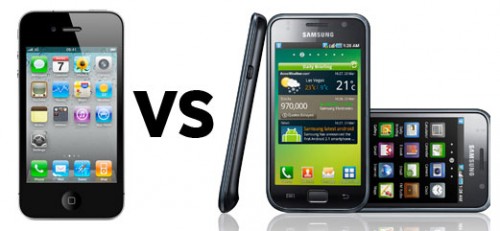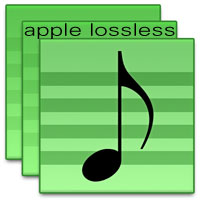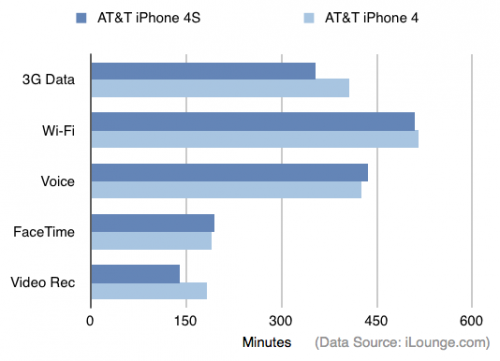News tagged ‘less’
Google Chairman Eric tells US senators Apple's Siri could pose 'competitive threat'
Eric Schmidt, Google’s chairman, admitted to the U.S. Senate antitrust subcommittee that Siri, voice assistant, could threaten his business and could supplant Google's search engine. Schmidt even went so far as to call Siri a "Google killer" and Apple's "entry point" into the search engine business.
On the contrary, Android chief Andy Rubin doesn’t believe that phones should be assistants and doubted whether people should communicate with their phones. But Schmidt denied his opinion, citing a recent study that shows that "Android operates on only 34.1 percent while Apple’s iOS runs on 43.1 percent."
Schmidt also downplayed Google's role in the search engine market, instead attributing it to hard work and luck.
"I would disagree that Google is dominant," he said after senators asserted that Google is approaching a monopoly. "By investing smartly, hiring extremely talented engineers, and working very, very hard (and with some good luck), Google has been blessed with a great deal of success."
Apple wants to improve OLED technology for potential use in future iPhones
Apple demonstrates interest in improving OLED technology for future iPhone and iPad displays that will provide better battery life for such devices. Earlier this week AppleInsider revealed a new patent application filled by Apple. The title of the patent is "Power Efficient Organic Light Emitting Diode Display" and describes different ways that could improve battery life, for example, displaying the color white.
OLED displays consume less power than traditional displays. This is possible because OLED technology is light emissive rather than light transmissive. But OLED displays, despite all their advantages, are less efficient that it is used for displaying a screen that is largely the color white, because an OLED panel has to utilize a range of color channels for every pixel on the display. Doing this can be power intensive and make the device inefficient.
For example, certain applications, such as word processing, spreadsheet design and use, database design and use, e-mail, and other business or productivity applications, typically utilize dark or black alphanumeric characters on a white background, such as to simulate writing or printing on a sheet of paper. As a result, these applications may cause the display of large expanses of white background with relatively little area devoted to the non-white alphanumeric characters. Such applications, therefore, may make the use of OLED displays unsuitable or undesirably power intensive for battery powered and/or portable electronic devices, such as handheld devices.
Apple Opened Redesigned Fifth Avenue Store Cube
Construction crews spent the last few months revamping the 32-foot glass cube, which previously consisted of 90 glass panes. The new cube features 15 larger panes of glass, and it is almost “seemless” without nearly all of the hardware, which previously held glass panes together.
 Leave a comment, read comments [1]
Leave a comment, read comments [1]
CEO Tim Cook looks to mold a more streamlined Apple
Two months has already gone since the moment when Tim Cook was appointed Apple’s CEO. The Wall Street Journal decided to take a look at his management strategy and found out some differences between his style and that of Steve Jobs.
In recent weeks, Mr. Cook has tended to administrative matters that never interested Mr. Jobs, such as promotions and corporate reporting structures, according to people familiar with the matter. The new chief executive, 50 years old, has also been more communicative with employees than his predecessor, sending a variety of company-wide emails while addressing Apple employees as "Team," people close to the company said.
Cook made significant changes in Apple’s education division. As a result the division was divided into marketing and sales divisions and then reintegrated with the company's broader arms focused on those aspects of the business. Another corporate-level change is recently-announced charitable matching program that calls for Apple to match employee donations up to $10,000 per year, a change from the Jobs who was reportedly against giving money away. Cook seems to recognize quickly expertise and achievements of his employees, and ready to promote them, such as with the promotion of Eddy Cue.
Tests Showed That Siri Doesn’t Consume Much Network Data
Siri, exclusive to iPhone 4S digital assistant, requires a network connection to interact with Apple cloud in order to get answers, the company said at the iPhone 4S unveiling. In order to find out how much traffic does Siri consume, Ars Technica eleven tests, using Siri to make five network operations such as searching information on Wolfram|Alfa and other sources and six local tasks, including setting up reminders, alarms, dictation and other.
South Korea repeals ban on iOS games ahead of iPhone 4S launch
The Next Web reported that South Korea had removed a ban blocking App Store games a week before the iPhone 4S launch. Korea opened up the local App Store earlier today. The Store had been closed for about two years. Of course, such ban cannot but affect Korean game developers. The selection of available games in the Korean App Store is limited for now, but it is expected to improve quickly.
The iPhone 4S is believed to face with tough competition in the region from the local giant Samsung, especially from the latest Galaxy Nexus. But Apple will obviously achieve success, predicting huge demand for their newest smartphone. Moreover, worldwide sales of the iPhone 4S are breaking all records. In the first three days of availability Apple sold four million units.
Nevertheless, Samsung intends to target Apple with new patent suits after iPhone 4S launch in Korea, even despite the fact that all their previous attempts were unsuccessful.
Samsung requests iPhone 4S firmware source code
SmartOffice reports that Samsung is requesting Apple to provide them with the source code for the iPhone 4S firmware. Samsung doesn’t abandon their attempt to ban the device in Australia, trying to find any loophole to achieve success. Moreover, Samsung wants to know details of subsidy agreements with all Australian carriers.
“It goes to show that since the iPhone 3G was made available in Australia in July 2008, the impact on the market for every iPhone product has been significant, and has lead to a substantial increase … in market share by revenue. If subsidies are given for the iPhone 4S, there are less to go around for my client’s products,” - Samsung counsel Cynthia Cochrane told the federal court.
As for the source code Apple denies any infringement. The Company claims that Samsung agreed to license the three wireless 3G-related patents in question under FRAND agreements. Samsung thinks that agreement doesn’t cover Apple in Australia and claims Apple denied previous attempts to extend the license internationally. But it seems that all Samsung’s attempts will be unsuccessful, because the case will be handled by Justice Annabelle Bennett, who handed out the injunction against Samsung’s Tab 10.1.
 Leave a comment, read comments [1]
Leave a comment, read comments [1]
Rumors: iMessage and AirPlay Mirroring Will Be Integrated In Mac OS X Lion
Airplay Mirroring demo on an iPad 2
Reportedly, iMessage and AirPlay Mirroring will be added to OS X Lion. AirPlay Mirroring was first launched on the iPhone 4S and iPad 2. It enables you to wirelessly stream display content of your iPhone or iPad to the HDTV through Apple TV. Implementation of this feature on the Mac will reportedly be similar and will allow broadcasting whatever is on your desktop to your TV.
Jailbreak & Unlock tutorials and FAQ
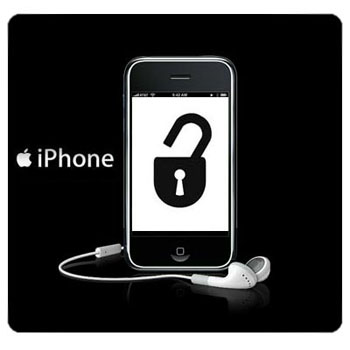
UPDATE: Apple released new iOS versions and has stopped signing all other firmwares, including iOS 6.1.2 and iOS 5.1.1. This means you can NOT restore to 6.1.2/5.1.1/4.3.3 and others any more (both original and custom), unless you have saved your SHSH keys for it.
If you have decided to perform an untethered jailbreak and unlock, you need to get the following information:
- What type of device do you have (iPhone 3G/3GS/4, iPod Touch 3G/4G, iPad 1/2, Apple TV)?
- Do you need unlock (if your iPhone locked to one carrier and you want to use it with another)?
The answer is NO, if the device is not iPhone, if it was purchased as factory unlocked and can be used with any cellular carrier (f.e. in Canada, France, etc).
If the answer is YES, you need to find out your modem version (Setting-General-About-Modem). - What firmware version do you have? Take a look at Setting-General-About-Version. For example it could be iOS 4.3.3.
- What operating system do you use on your desktop (Windows, Mac OS)?
How to perform jailbreak, when you do NOT need an unlock
For iPhone 3G the latest is iOS 4.2.1. You can perform jailbreak with any utility. For iOS 4.2.1 you can also use them or GreenPois0n (Windows, Mac OS).
iPad 2 jailbreak is available for iOS 4.3.3 via JailbreakMe and iOS 5.0.1 / iOS 5.1.1 via Absinthe, iOS 6.0-6.1.2 and iOS 7.0-7.0.4 via Evasi0n, iOS 7.1-8.1 via Pangu, iOS 8.1.1-8.4 via TaiG, untethered iOS 9.0-9.0.2 via Pangu9.
iPad 3 jailbreak is available for iOS iOS 5.1.1 via Absinthe, iOS 6.0-6.1.2 and iOS 7.0-7.0.4 via Evasi0n, iOS 7.1-8.1 via Pangu, iOS 8.1.1-8.4 via TaiG, untethered iOS 9.0-9.0.2 via Pangu9.
iPhone 4S jailbreak is available for iOS 5.0 / iOS 5.0.1 / iOS 5.1.1 via Absinthe, iOS 6.0-6.1.2 and iOS 7.0-7.0.4 via Evasi0n, iOS 7.1-8.1 via Pangu, iOS 8.1.1-8.4 via TaiG, untethered iOS 9.0-9.0.2 via Pangu9.
iPhone 3GS, iPhone 4, iPod Touch 3G, iPod Touch 4G, iPad jailbreak is untethered for iOS 5.1.1 and iOS 6.0-6.1.4.
iPhone 5/5C/5S/6/6plus, iPad 4, iPod Touch 5G jailbreak is untethered for iOS 6.0-6.1.2 and iOS 7.0-7.0.4 via Evasi0n, untethered for iOS 7.1-8.1 via Pangu, iOS 8.1.1-8.4 via TaiG, untethered iOS 9.0-9.0.2 via Pangu9.
iPhone 6S / 6S+ / 6 / 6+ jailbreak is untethered for iOS 8.1.1-8.4 via TaiG, untethered iOS 9.0-9.0.2 via Pangu9.
iPad Mini / Mini 2 / Mini 3 / Mini 4 / Air / Air 2 jailbreak is untethered for iOS 7.0-7.0.4 via Evasi0n, untethered for iOS 7.1-8.1 via Pangu, iOS 8.1.1-8.4 via TaiG, untethered iOS 9.0-9.0.2 via Pangu9.
iOS 4.3.3
Apple stopped signing iOS 4.3.3, so you cannot update to iOS 4.3.3 without SHSH keys saved (in advance some time ago). If you have iPhone 4, iPhone 3GS, iPad 1, iPod Touch 3G or iPod Touch 4G that run iOS 4.3.3 - use JailbreakMe or RedSn0w to untether jailbreak your device.
If you have saved SHSH keys for iOS 4.3.3 you can use PwnageTool (Mac OS) or Sn0wBreeze (Windows).
iOS 4.3.4/4.3.5
For iOS 4.3.4/4.3.5 only tethered jailbreak is possible with redsn0w. Tethered means that each time you restart your device you will have to connect it to a computer and run redsn0w. The untethered iOS 4.3.5 jailbreak is possible only for iPhone 3GS with old bootrom. You can detect your bootrom version using this tutorial.
iOS 5
To jailbreak and unlock iOS 5 use latest version of redsn0w 0.9.9 or sn0wbreeze 2.8. You can jailbreak tethered or semi-tethered.
The untethered iOS 5 jailbreak is possible only for iPhone 3GS with old bootrom. You can detect your bootrom version using this tutorial.
iOS 5.0.1
For iPhone 4/3GS, iPad 1, iPod Touch 3G/4G an untethered jailbreak is available for iOS 5.0.1. For untethered jailbreak use the latest redsn0w 0.9.10 or Corona - package from Cydia to untether currently installed tethered jailbreak.
Tutorial how to untether installed tethered jailbreak is available here.
For iPhone 4S and iPad 2 use Absenthe.
For tethered iOS 5.0.1 jailbreak you an use redsn0w 0.9.9 and sn0wbreeze 2.8.
iOS 5.1
For now only tethered jailbreak is available for iPhone 4/3GS, iPad 1 and iPod Touch 3G/4G for iOS 5.1.
iOS 5.1.1
You can do an untethered jailbreak for iPhone 4S, iPhone 4, iPhone 3GS, iPad 3, iPad 2, iPad 1, iPod Touch 3G, iPod Touch 4G and Apple TV2G.
Use Absinthe 2.0.4 or RedSn0w 0.9.12 (for all iPhones, iPods and iPads), Sn0wBreeze 2.9.5 (for all A4 devices) and Seas0npass (for Apple TV 2G).
Tutorial how to untether installed tethered jailbreak is available here.
iOS 6.0-6.1.2
Untethered jailbreak is available for all devices with iOS 6.0 - iOS 6.1.2. It is called Evasi0n.
iOS 6.1.3-6.1.5
Tethered jailbreak is available for old devices (iPhone 3GS, iPhone 4, iPod Touch 4) and Cydia package to make it intethered.
iOS 7.0 - 7.0.4
Untethered jailbreak is available for all devices with iOS 7.x, including iPhone 5S/5C and iPad Air. Utility is called Evasi0n 7.
iOS 7.1 - 7.1.2
Untethered jailbreak is available for all devices with iOS 7.x, including iPhone 5S/5C and iPad Air. Utility is called Pangu.
iOS 8.0 - 8.1
Untethered jailbreak is available for all devices with iOS 8.x, including iPhone 5S / 5C / 6 / 6+ and iPad Air /Air 2 / Mini / Mini 2 / Mini 3. Utility is called Pangu8.
iOS 8.1.1 - 8.4
Untethered jailbreak is available for all devices with iOS 8.0-8.1.2 including iPhone 5S / 5C / 6 / 6+ and iPad Air /Air 2 / Mini / Mini 2 / Mini 3. Utility is called TaiG.
iOS 9.0 - 9.0.2
Untethered jailbreak is available for all devices with iOS 9.0-9.0.2 including iPhone 6S / 6S+ / 6 / 6+ / 5S / 5C / 6 / 6+ and iPad Air /Air 2 / Mini / Mini 2 / Mini 3. Utility is called Pangu9.
You can download all firmwares here.
Tutorials
Here are our step-by-step tutorials that will guide you through the jailbreak process:
![]() iPhone 5S / 5C / 6 / 6+
iPhone 5S / 5C / 6 / 6+
UnTethered jailbreak iOS 8.0 - iOS 8.3:
UnTethered jailbreak iOS 8.0 - iOS 8.1:
UnTethered jailbreak iOS 7.1 - iOS 7.1.2:
UnTethered jailbreak iOS 7.0 - iOS 7.0.4:
![]() iPhone 5
iPhone 5
UnTethered jailbreak iOS 8.0 - iOS 8.3:
UnTethered jailbreak iOS 8.0 - iOS 8.1:
UnTethered jailbreak iOS 7.1 - iOS 7.1.2:
UnTethered jailbreak iOS 7.0 - iOS 7.0.4:
UnTethered jailbreak iOS 6.0 - iOS 6.1.2:
![]() iPhone 4S
iPhone 4S
UnTethered jailbreak iOS 8.0 - iOS 8.3:
UnTethered jailbreak iOS 8.0 - iOS 8.1:
UnTethered jailbreak iOS 7.1 - iOS 7.1.2:
UnTethered jailbreak iOS 7.0 - iOS 7.0.4:
UnTethered jailbreak iOS 6.0 - iOS 6.1.2:
UnTethered jailbreak iOS 5.1.1
UnTethered jailbreak iOS 5.0 / iOS 5.0.1:
 iPhone 4
iPhone 4
UnTethered jailbreak iOS 7.0 - iOS 7.0.4:
UnTethered jailbreak iOS 7.0 - iOS 7.0.4:
UnTethered jailbreak iOS 6.0 - iOS 6.1.2:
Tethered jailbreak iOS 6.0.1
Tethered jailbreak iOS 6
UnTethered jailbreak iOS 5.1.1
Tethered jailbreak iOS 5.1.1:
Tethered jailbreak iOS 5.1:
UnTethered jailbreak iOS 5.0.1:
- RedSn0w (Windows)
- Custom firmware using RedSn0w
- Custom firmware using Sn0wBreeze (Windows)
- Custom firmware using PwnageTool (Mac)
Semi-Tethered jailbreak iOS 5:
Tethered jailbreak iOS 4.3.5:
UnTethered jailbreak iOS 4.3.3:
- RedSn0w (Windows)
- RedSn0w (Mac OS)
- PwnageTool (Mac OS)
- Sn0wBreeze (Windows)
- JailbreakMe (works without a computer)
 Leave a comment, read comments [606]
Leave a comment, read comments [606]
Apple Has Made Audio Codec (ALAC) Open Source
Apple has announced via that the company is launching the Apple Lossless Audio Codec on an open source basis.
“Apple is making the Apple Lossless Audio Codec (ALAC) available as an open source project. Full details can be found on the Apple Lossless Audio Codec ”.
'It's time to repeal prohibition' on Macs in the enterprise
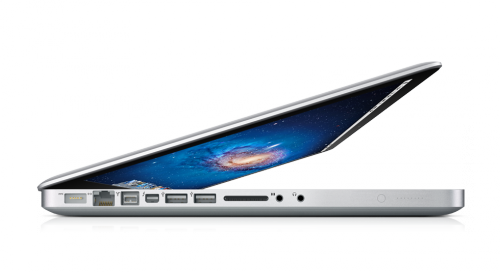
According to Forrester research, Mac business users are more productive than their PC counterparts, because MacBook laptops from Apple tend to be more reliable and require less maintenance than PCs. Forrester issued a new report entitled "People are Bringing Macs to Work - It's Time to Repeal Prohibition" in order to encourage companies to support Apple hardware in the workplace.
Although the use of Mac in enterprises is increasing, approximately 41 percent of companies that took part in the research do not officially allow their employees to use Mac. Of course, users find ways how bypass company restrictions and use their Mac at work.
Moreover, Mac sales in the enterprise sector have seen a huge spike in 2011. In May, Apple announced that corporate Mac sales grew by 66 percent. But sales of iOS products are more significant. 93 percent of Fortune 500 companies are deploying or testing the iPhone, while 90 percent are doing the same for the iPad.
Apple Looking to Launch Siri-Enabled Television Set by 2013
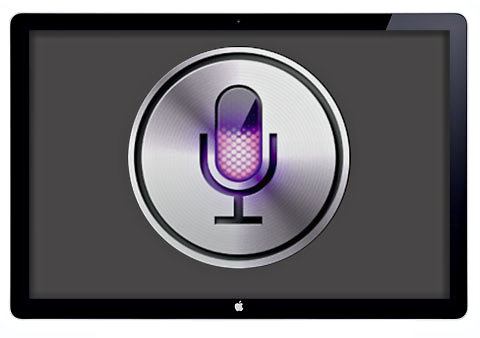
Nick Bilton at the New York Times is pretty sure that Apple is building a television set. It is believed that the TV set will include Siri voice recognition service. Apple could announce the new set by the end of 2012 with public reliance in 2013. Anonymous sources say that an Apple television is a "guaranteed product for Apple" because "Steve thinks the industry is totally broken."
The rumors about Apple’s television set have been circulating for years, perhaps as far back as 2007, since the launch of the first iPhone. Some days ago we reported that Apple now is making prototypes of the Apple TV.
It’s the stuff of science fiction. You sit on your couch and rather than fumble with several remotes or use hand gestures, you simply talk: “Put on the last episode of Gossip Girl.” “Play the local news headlines.” “Play some Coldplay music videos.” Siri does the rest.
As the line between television programming and Web content continues to erode, a Siri-powered television would become more necessary. You aren’t going to want to flip through file folders or baskets of content, checking off what you want. Telling Siri to “play videos of cute cats falling asleep” would return an endless YouTube stream of adorable napping fur balls.
Bilton also reports that Apple still has “quite a bit of work to do on the project.” But the launch of the new Apple’s television set is just a matter of time.
iPod Turns 10 Years Old
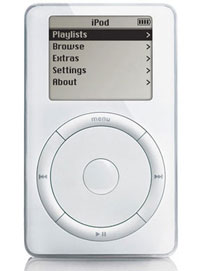
Ten years ago, on October 23rd, Steve Jobs introduced the first iPod. This music player seems to be partly responsible for Apple’s comeback and success. It also paved Apple the way to the consumer electronics market. Macworld provides a nice story detailing how the iPod came to be:
Behind every successful product lies a problem in search of a solution. The inspirational problem, in the iPod’s case, involved the pitiful state of the young MP3 player market in the late 1990s.
Portable MP3 players had been around since the mid 1990s, but Apple found that every one on the market offered a lackluster user experience. Steve Jobs had a strong term for gadgets like that: “crap”. Everyone at Apple agreed.
Initial reaction to the iPod wasn’t favorable. Customers complained against lack of wireless and space. They called it “lame” and thought that the iPod would never start taking off. But time tells that all those critics were wrong. Now iPod line of portable music players is one of the most popular worldwide. Ten years after the launch, the iPod has sold over 304 million units.
iPhone 4S Component Costs Once Again Begin at About $188
We have already seen some teardowns and estimates of the cost of the new iPhone 4S by iFixit and Chipworks. Now iSuppli offers its teardown and some new facts.
In the case of the iPhone 4S, [IHS iSuppli analyst Andrew] Rassweiler estimates that the BOM cost ranges from $188 for the 16 gigabyte version of the iPhone 4S to $207 for the 32GB version and $245 for the 64GB version. Apple and its carrier partners sell the phones for $199, $299 and $399 respectively, typically with a two-year contract for wireless service that carriers use to subsidize the cost they pay Apple.
iSuppli didn’t find in the iPhone 4S a noise cancellation chip from Audience that was found in the iPhone 4. Such function may be implemented directly into A5 cheap that costs about $15. While iFixit found Toshiba flash memory in its iPhone 4S unit, IHS iSuppli expressed some surprise at finding Hynix memory in its unit. But as far as we know, Apple sources flash memory chips from different manufactures. They didn’t managed to find the manufacturer of the camera sensor, but estimated the cost of the camera module at $17.60.
iPhone 4S Battery Life Worse for 3G Data and Media as Compared to iPhone 4
iLounge has tested the iPhone 4S battery life, comparing it with the iPhone 4, and found out several interesting facts. As Apple claims in the iPhone 4S official specifications, the new smartphone has improved talk time but worse standby time as compared to the iPhone 4.
For tests with 3G Data, Audio Playback, Video Playback, and Video Recording, the iPhone 4S came in under the iPhone 4's battery life. For Wi-Fi and FaceTime testing it to be similar to the iPhone 4, and on Cellular Calls, the iPhone 4S is slightly better. Both media playback and recording were advantage of the iPhone 4S, comparing with the iPhone 4. The iPhone 4S is recording much higher resolution video than the iPhone 4.
 Leave a comment, read comments [1]
Leave a comment, read comments [1]
